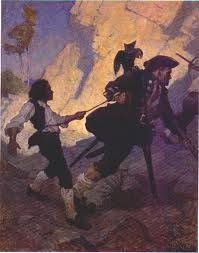Barber – Summer Music for Wind Quintet (Part 1) – YouTube.
A fine professional ensemble (Ensemble Wien-Berlin) handles this difficult but stunningly beautiful music–one of the very great wind quintets ever written. See also Part 2 on YouTube (link below) for the conclusion of this piece. Both posts, by the way, include the music so if you read music you can follow along! Flute part is at the top, then oboe, then clarinet, then horn, then at the bottom bassoon.
Rightly called “Summer Music,” this piece evokes the ebullient energy of summer as powerfully as a poem like Wallace Stevens’ “Credences of Summer.” This power is nicely captured by the bubbly arpeggios of the flute, clarinet, and bassoon, which often gurgle underneath the other music lines and, in other sections, are front and center, flowing leisurely in counterpoint. They are optimistic, effervescent, confident of endless sunshine. They dance. At the end of the piece (in Part 2 in the YouTube excerpt) their notes fly upwards exuberantly like a flight of birds to make an end. At times Barber sounds to my ear like he’s tipping his hat here and there to Stravinsky, especially his wind pieces from the 1920s, like the Octet. And of course the lively ghost of Mozart hovers kindly in the background. But it’s all also inimitably Barber’s own, especially because of what happens with the horn and oboe parts.
For all their liveliness, the horn and oboe parts speak often not of summer’s fullness but of something else that’s hard to name—something that’s definitely sounded in a minor key, not a major key. The horn and oboe parts thus sometimes contrast with the bubbly excitement of the other winds, sounding against them, under them, beyond them. Their notes are often long drawn out, not quick runs up and down the scale. They evoke a different emotion and make me feel that before my eyes (and ears) a beautiful summer’s day is turning into evening. It’s a counterpoint to pure effulgence, one that doesn’t negate it but makes such optimism all the more precious because its sunniness is cast against a darker backdrop. Hard to put into words, but the horn and oboe parts make my eyes sting with tears just about every time I hear this piece. Those plangent, minor, repeated held tones of the oboe and horn sound for me notes of loss and yearning, the music of the transcience of all things. I hear and feel time passing. This side of “Summer Music” is more like Stevens’ great elegy “Auroras of Autumn.”
I’m no musician, nor am I an expert commentator on music adept with all the techical knowledge and terms. So I rely on analogies and metaphors to describe my reactions. But they too are a part of what music does. As I write this on an August evening, through the window I can hear crickets and in the distance the surf of traffic on a local highway….
Thank you szilszabee for posting this on YouTube!
Barber – Summer Music for Wind Quintet (Part 2) – YouTube.
This performance of Barber’s “Summer Music” by Ensemble Wien-Berlin is available on Sony CD, Twentieth Century Wind Music.

